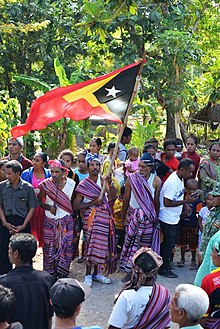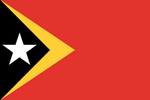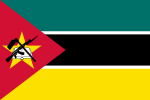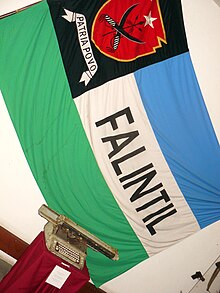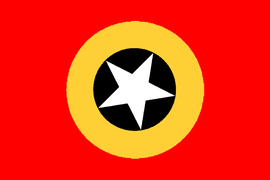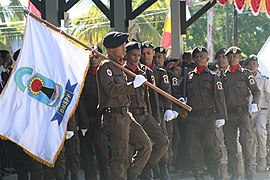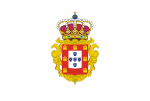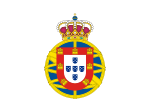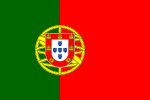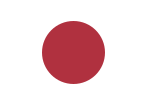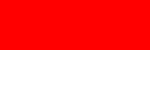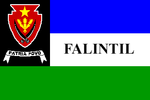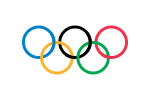
José Alexandre "Xanana" Gusmão is an East Timorese politician. He has served as the 6th prime minister of East Timor since 2023, previously serving in that position from 2007 to 2015. A former rebel, he also served as East Timor's first president since its re-establishment of independence, from 2002 to 2007.

The political system in East Timor is a unitary semi-presidential representative democratic republic, whereby the Prime Minister of East Timor is the head of government and the President of East Timor functions as head of state. East Timor has a multi-party system. Executive power is exercised by the president and the government. Legislative power is vested in both the government and the National Parliament. The Judiciary is independent of the executive and the legislature. The East Timorese constitution was modelled on that of Portugal, with lesser power given to the president. The country is still in the process of building its administration and governmental institutions. The Economist Intelligence Unit rated East Timor a "flawed democracy" in 2022.

The Revolutionary Front for an Independent East Timor is a centre-left political party in East Timor. It presently holds 23 of 65 seats in the National Parliament. Fretilin formed the government in East Timor until its independence in 2002. It obtained the presidency in 2017 under Francisco Guterres but lost in the 2022 East Timorese presidential election.

Mari bin Amude Alkatiri is a Timorese politician. He was Prime Minister of East Timor from May 2002 until his resignation on 26 June 2006 following weeks of political unrest in the country, and again from September 2017 until May 2018. He is the Secretary-General of the Fretilin party and was the former President of the Special Administrative Region of Oecusse.

Francisco Xavier do Amaral was an East Timorese politician. A founder of the Frente Revolucionária de Timor Leste Independente (Fretilin), Amaral was sworn in as the first President of East Timor when the country, then a Portuguese colony, made a unilateral declaration of independence on 28 November 1975. He was a member of the National Parliament for the Timorese Social Democratic Association from 2001 until his death in 2012. Amaral was also known as "Abo (Grandfather) Xavier", a term of endearment, by East Timorese.

The Social Democratic Party is an East Timorese party founded on 20 September 2000. Despite its name, the party, like its Portuguese model, is usually categorised as centre-right in the political spectrum. It describes itself as being in the middle between left and right (centrist). The aim of the party's founders was to offer voters a moderate alternative to Fretilin and UDT. In 2002, the party had 8,000 members. Since then, the PSD has lost its importance. The PSD did not contest the 2023 parliamentary elections in East Timor.

The Timorese Democratic Union is a conservative political party in East Timor. It was the first party to be established in the country on May 11, 1974, following the Carnation Revolution in Portugal.

The People's Party of Timor is a conservative political party in East Timor. Its predecessor was the Movimento do Povo de Timor-Leste MPTL. The PPT is described as a conservative, backward-looking traditional party with utopian ideas and monarchist and religious tendencies.

The national emblem of East Timor is one of the national symbols of East Timor.

The Armed Forces for the National Liberation of East Timor originally began as the military wing of the Fretilin party of East Timor. It was established on 20 August 1975 in response to Fretilin's political conflict with the Timorese Democratic Union (UDT).

The Indonesian invasion of East Timor, known in Indonesia as Operation Lotus, began on 7 December 1975 when the Indonesian military (ABRI/TNI) invaded East Timor under the pretext of anti-colonialism and anti-communism to overthrow the Fretilin regime that had emerged in 1974. The overthrow of the popular and short-lived Fretilin-led government sparked a violent quarter-century occupation in which approximately 100,000–180,000 soldiers and civilians are estimated to have been killed or starved to death. The Commission for Reception, Truth and Reconciliation in East Timor documented a minimum estimate of 102,000 conflict-related deaths in East Timor throughout the entire period from 1974 to 1999, including 18,600 violent killings and 84,200 deaths from disease and starvation; Indonesian forces and their auxiliaries combined were responsible for 70% of the killings.

José Maria de Vasconcelos, popularly known as Taur Matan Ruak, is an East Timorese politician who served as 8th prime minister of East Timor from 2018 to 2023. He also served as 5th president of East Timor from 2012 to 2017.

The National Council of Maubere Resistance was an umbrella organisation of East Timorese individuals and organisations dedicated to resisting the Indonesian occupation of 1975–1999.

The Constitution of East Timor entered into force on 20 May 2002, and was the country's first constitution after it gained independence from Portugal in 1975 and from Indonesia, which invaded East Timor on 7 December 1975 and left in 1999 following a UN-sponsored referendum.

Parliamentary elections were held in East Timor on 7 July 2012. The United Nations stated that it would withdraw its 1,300 troops if the elections passed off peacefully. The National Congress for Timorese Reconstruction, led by Prime Minister Xanana Gusmão, won the election with 30 seats, three seats short of a majority in National Parliament.
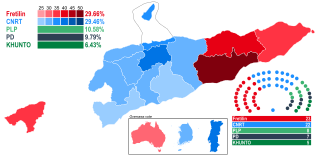
Parliamentary elections were held in East Timor on 22 July 2017. Fretilin narrowly emerged as the largest party in the National Parliament, winning 23 seats to the 22 won by the National Congress for Timorese Reconstruction, which had been the largest party in the outgoing Parliament.
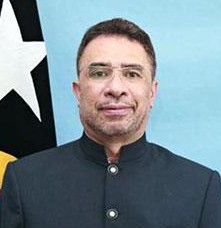
Hernâni Filomena Maria Coelho da Silva, also known by his nom de guerreNatan, is an East Timorese politician and diplomat, and a member of the Fretilin political party. He has been the East Timorese Ambassador to both Australia and South Korea. Between February 2015 and September 2017, he was Minister of Foreign Affairs and Cooperation, and from October 2017 to June 2018 he was Minister of Petroleum.

Proclamation of Independence Day is a national holiday and a celebration to commemorate East Timor Unilateral Declaration of Independence from the Portuguese rule in 1975. The event is annually celebrated on 28th November and marked by official and unofficial ceremonies and observances. The event is defined by East Timor parliament in the Law No. 10/2005 Of 10 August as part of its national holiday.

The 1975 Council of Ministers was the Council of Ministers formed by the Fretilin political party in 1975 as the inaugural administration or cabinet of the Democratic Republic of East Timor proclaimed in November 1975.

The Democratic Republic of East Timor, was a state that was unilaterally proclaimed on the territory of present-day East Timor on 28 November 1975 prior to the Indonesian invasion of East Timor nine days later on 7 December 1975.




